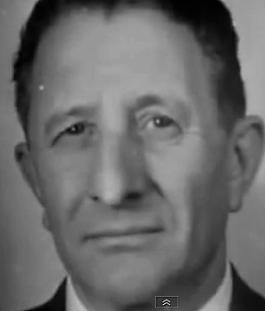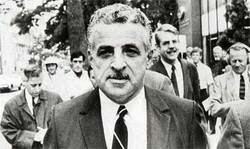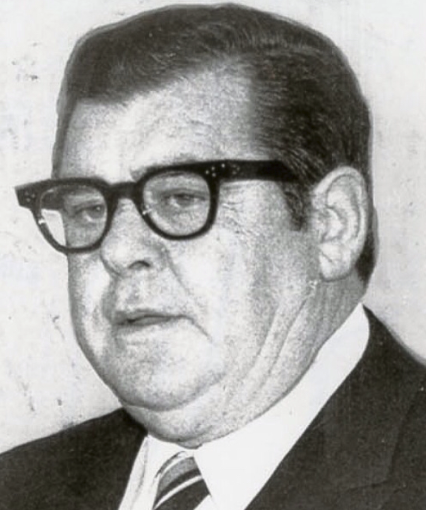Carlo Gambino's Aborted Plan to Consolidate The Five Families Into One Gambino Family
--Unnamed Mafia boss via surveillance recording
At the end of 1972, Carlo Gambino, boss of the Gambino crime family, was working on a "dramatic reorganization" of New York's Five Families, the likes of which had not been seen since 1931. As radical as this sounds, it is not unbelievable considering some events leading up to it. |
| Gambino |
Gambino, 70 at the time, believed the "Mafia must retreat to the past in order to survive," law enforcement officials said.
The first two crime families on the block were to be the Luchese and Colombo crime families. Then the Bonanno crime family.
"Twenty percent of known Mafia members in New York are currently under indictment in cases developed by the Federal Bureau of Investigation alone."
Gambino's ultimate goal was one crime family. Even though the Genovese crime family was even then considered the most powerful, after the Gambinos, Gambino was still planning to absorb all four families. This likely would've meant something like the ultimate Mafia war.
That's the thrust of a well-known New York Times story headlined Gambino Believed Seeking Single Mafia Family Here, which ran about 46 years ago, on Friday, Dec. 8, 1972. (I missed my deadline to publish yesterday.)
This Times story is referenced in several books, including Anthony DeStefano's The Big Heist, one of the best and most comprehensive books about the Lufthansa heist. The Times story is also referenced in Sal Polisi's The Sinatra Club,
The story is not part of the Joint Legislative Committee on Crime's discredited information. Edward J. McLaughlin, committee counsel, had called Aniello Dellacroce "a conniver plotting against Gambino." To tickle the wire, the committee planted "fake news" in newspaper stories of the day. (Still, some details no doubt crept into books and perhaps still stand today.) The committee was "outed" in March of 1970.
The Times story, rather, was based on interviews with "underworld sources and law enforcement officials," as well as wiretaps.
In other words, it seems pretty solid.
 |
| Sam the Plumber. |
Precedent?
There's wiretap evidence to suggest the New York bosses (well, at least four of them) had previously considered doing away with the Bonanno crime family.
There's wiretap evidence to suggest the New York bosses (well, at least four of them) had previously considered doing away with the Bonanno crime family.
New Jersey crime boss Simone Rizzo DeCavalcante had been consulted during the so-called "Banana War," which concluded with the New York Mafia's Commission expelling boss Joseph Bonanno from his position as overlord of the crime family that still carries his name.
According to the recording, this even included giving the Bonanno family's Montreal faction to Stefano Magaddino, then the powerful boss of the Buffalo crime family.
DeCavalcante was recorded saying: "You know, they were going to give the guys in Canada away to Buffalo."
“Either you go along with Carlo or you go to war against him, and nobody can take him on,” a Federal agent is quoted saying in the story, written by Nicholas Gage. A PDF of the story is available at the end.
Gambino's motive?
To shore up the mob (more likely protect his empire), Gambino, according to the report, planned to:
Gambino also wanted to rid the city of members because many -- including "established members" -- had "grown soft." As a result, these members were vulnerable to pressure from law‐enforcement agencies. Gambino was concerned that many of them would flip to avoid prison.
However, according to Sam the Plumber's recorded conversations, the Commission almost went a step further, by talking about distributing Bonanno's territory (meaning today we'd likely be referring to the "Four Families").
According to the recording, this even included giving the Bonanno family's Montreal faction to Stefano Magaddino, then the powerful boss of the Buffalo crime family.
DeCavalcante was recorded saying: "You know, they were going to give the guys in Canada away to Buffalo."
 |
“Either you go along with Carlo or you go to war against him, and nobody can take him on,” a Federal agent is quoted saying in the story, written by Nicholas Gage. A PDF of the story is available at the end.
Gambino's motive?
Gambino was seeking to take action reportedly due to "growing law enforcement pressure and persistent internal conflicts," which Gambino thought "would destroy the five families here unless they were restructured into a tighter and stronger network."
To shore up the mob (more likely protect his empire), Gambino, according to the report, planned to:
- Reduce the number of New York families to two or three, then one
- Expel "hundreds" of Mafia members who evidenced weaknesses and constituted a risk to the security or stability of the organization.
- Reopen the membership books to allow initiation of men with proven strength and ability.
Such a reorganization was "crucial," because of the "tremendous pressure" New York's Five Families were facing from various law enforcement agencies, but most notably, the FBI, which seemed to be poised to join the NYPD and local law enforcement in taking down the Mafia. (That didn't happen, however, until J. Edgar Hoover's 1973 death, and it wasn't until another decade or so that law enforcement began using the RICO act earnest.)
As the Times report noted:
"Until recent years Federal law enforcement agencies neither had the jurisdiction nor devoted the manpower to have an impact on organized crime.
"But new laws and revised priorities have changed all that. As a result, 20 percent of known Mafia members in New York are currently under indictment in cases developed by the Federal Bureau of Investigation alone."
As of December 1970, the NYPD and various of the city's district attorneys -- most notably, Eugene Gold of Brooklyn -- had put "their best men to organized‐crime investigations, and they have developed major Mafia cases as well."
As the Times report noted:
"Until recent years Federal law enforcement agencies neither had the jurisdiction nor devoted the manpower to have an impact on organized crime.
"But new laws and revised priorities have changed all that. As a result, 20 percent of known Mafia members in New York are currently under indictment in cases developed by the Federal Bureau of Investigation alone."
As of December 1970, the NYPD and various of the city's district attorneys -- most notably, Eugene Gold of Brooklyn -- had put "their best men to organized‐crime investigations, and they have developed major Mafia cases as well."
Mafia's Decline
"Mafia bosses such as Vito Genovese, Thomas Luchese, and Joseph Profaci died and were succeeded by less forceful leaders. As a result, some of the families have become weak and undisciplined and their members have grown careless.
"Part of Gambino's solution to this decline reportedly is to dissolve some of the weak families and absorb their best men in the surviving groups."
Carmine Tramunti was running the Luchese crime family (into the ground?) at the time, and Gambino clearly had him in the crosshairs. The relatively small Luchese family had been highly prosperous when its namesake boss was alive and at the helm. He and Gambino had been close to the extent that Luchese's daughter married one of Gambino's sons. Luchese (allegedly Lucky Luciano's "favorite hit man") was known to have the most political connections of any Mafia boss in the city. Those connections, however, faded after Luchese's death in 1967 (cancer).
Earlier in 1970, the Gold Bug operation was revealed in which Luchese capo Paul Vario, described then to be "the third most important man in the family," had been bugged for six months without anyone finding out about it.
As the Times noted, the operation led to 678 subpoenas and numerous indictments, including one for contempt of a grand jury against Tramunti, the family boss. Vario himself faced seven indictments. It wasn't until 1972 that the worst of it would be revealed.
Joseph A. Colombo Sr. was shot on June 28, 1971, and put into a coma from which he never emerged. Most of the other major figures in the family were either in prison, fugitives or under indictment.
The Colombos also had split into a factional shooting war, again, thanks to the Gallo brothers. Joe Gallo had been killed in April 1972 -- allegedly in retaliation for the Colombo shooting, but who knows. Gambino himself may have ordered the shooting, based on the fact that he had ordered the dockworkers he controlled not to attend the Columbus Day rally.
Bonannos
Natale "Joe Diamond" Evola was running the Bonannos. The Times noted that "he was respected by Gambino" and the family had prospered. Still, "the seeds of the conflict that raged in the family after its leader of 30 years, Joseph Bonanno, was forced out for plotting to kill Gambino are still in the family. Dissolving it may be the only way to root them out."
The Times story clearly noted that the Genovese crime family, "the most powerful for many years under such leaders as Lucky Luciano, Frank Costello and Genovese" would be "the most difficult" for Gambino to absorb.
"It is still second only to the Gambino group, with a membership of more than 500. Although the family declined after Genovese went to jail in 1959 (he died there 10 years later), it now is headed by Frank Tieri, 67, who commands respect among Mafia bosses across the country."
Law enforcement officials expected the alleged merging into one family would take several years, and that Gambino likely would "run into problems when it comes to the Genovese group."
Still, they said, "Gambino's goal is one family for New York."
"Part of Gambino's solution to this decline reportedly is to dissolve some of the weak families and absorb their best men in the surviving groups."
 |
| Tramunti, "Mr. Gibbs" |
Earlier in 1970, the Gold Bug operation was revealed in which Luchese capo Paul Vario, described then to be "the third most important man in the family," had been bugged for six months without anyone finding out about it.
As the Times noted, the operation led to 678 subpoenas and numerous indictments, including one for contempt of a grand jury against Tramunti, the family boss. Vario himself faced seven indictments. It wasn't until 1972 that the worst of it would be revealed.
Joseph A. Colombo Sr. was shot on June 28, 1971, and put into a coma from which he never emerged. Most of the other major figures in the family were either in prison, fugitives or under indictment.
The Colombos also had split into a factional shooting war, again, thanks to the Gallo brothers. Joe Gallo had been killed in April 1972 -- allegedly in retaliation for the Colombo shooting, but who knows. Gambino himself may have ordered the shooting, based on the fact that he had ordered the dockworkers he controlled not to attend the Columbus Day rally.
Bonannos
Natale "Joe Diamond" Evola was running the Bonannos. The Times noted that "he was respected by Gambino" and the family had prospered. Still, "the seeds of the conflict that raged in the family after its leader of 30 years, Joseph Bonanno, was forced out for plotting to kill Gambino are still in the family. Dissolving it may be the only way to root them out."
 |
| Bonanno boss Evola |
The Times story clearly noted that the Genovese crime family, "the most powerful for many years under such leaders as Lucky Luciano, Frank Costello and Genovese" would be "the most difficult" for Gambino to absorb.
"It is still second only to the Gambino group, with a membership of more than 500. Although the family declined after Genovese went to jail in 1959 (he died there 10 years later), it now is headed by Frank Tieri, 67, who commands respect among Mafia bosses across the country."
Law enforcement officials expected the alleged merging into one family would take several years, and that Gambino likely would "run into problems when it comes to the Genovese group."
Still, they said, "Gambino's goal is one family for New York."
"His power is such that he is meeting only the most cautious resistance from other Mafia leaders in the city."
Bosses in other parts of the country "have stated clearly that they believe New York is too big for just one" crime family.
Gambino also wanted to rid the city of members because many -- including "established members" -- had "grown soft." As a result, these members were vulnerable to pressure from law‐enforcement agencies. Gambino was concerned that many of them would flip to avoid prison.
"The only way to secure against such risks, Gambino was said to maintain, is to expel or retire all members who may be vulnerable in any way."
There, of course, was another way to "expel" members. Gambino, however, was known for not having a hair-trigger temper when it came to killing people.
There, of course, was another way to "expel" members. Gambino, however, was known for not having a hair-trigger temper when it came to killing people.
Comments
Post a Comment